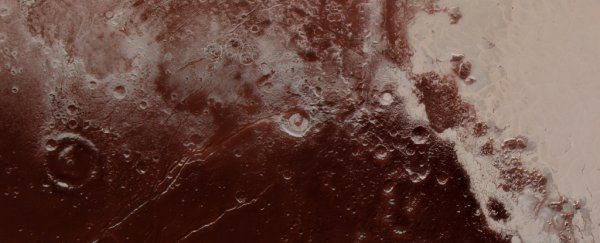Astronomers have detected the presence of ammonia mixed in with the rusty colouration of Pluto's surface. This could have fascinating implications for the icy dwarf planet, as researchers have detailed in two new studies.
Firstly, that ammonia-tainted ice hints at a salty, organic-rich ocean hiding beneath Pluto's surface - one that may contain the right ingredients for life. It also hints at the presence of elusive ice volcanoes, drawing the water and ammonia from underground and spewing it all over the surface.
The data comes from New Horizons, the spacecraft that flew by the dwarf planet in 2015. As it made its closest encounter, the probe's instrumentation was furiously collecting data - including a near-infrared spectrum of the Virgil Fossa, a region deeply tinted a rich brownish red.
Signatures in the near-infrared spectrum were consistent with ammonia ice mixed with water ice in some parts, and in others, ammonia ice without water ice.
 (Dalle Ore et al., Sci Adv, 2019)
(Dalle Ore et al., Sci Adv, 2019)
"This was a huge surprise to all of us about Pluto," planetary scientist Dale Cruikshank of the NASA Ames Research Center told Science News. "It means there are lots of surprises waiting to be uncovered in that part of the Solar System."
What makes it even more surprising is that ammonia doesn't last long (in cosmic terms) out in the open in the Solar System. Ultraviolet light and cosmic radiation degrade it relatively quickly - we're talking along the lines of millions of years.
Pluto is billions of years old, so something had to have put it there - and recently, too.
There's a clue in the way the ammonia is distributed: it seems to have been spewed out by several cryovolcanic vents: volcanoes that erupt subzero liquid volatiles such as water, methane and ammonia instead of molten rock.
This adds to the growing body of evidence supporting liquid oceans below Pluto's frigid surface that can plummet down to -230 degrees Celsius. A paper released earlier this month put forward that a layer of gas trapped beneath Pluto's surface ice could be insulating the water and keeping it from freezing after it's been melted by warmth from Pluto's core.
The presence of ammonia is another piece of the puzzle. It's a natural antifreeze that can lower the freezing point of water by up to 100 degrees Celsius.
It's long been thought that icy bodies such as Pluto might have cryovolcanoes, so finding supporting evidence for that theory is deeply rewarding, as well as support for the hypothesised subsurface oceans.
But the presence of ammonia could have other implications. It's thought Pluto's redness comes from molecules known as tholins, organic compounds that form when ultraviolet or cosmic radiation cooks compounds that contain carbon, such as methane or carbon dioxide.
The fact that the redness appears in conjunction with water and ammonia suggests there could also be organic compounds in the water.
And laboratory experiments have shown that irradiating ammonia and organic compounds with ultraviolet light can produce molecules that create life's building blocks, such as the nucleobases that make up RNA and DNA.
"The red material associated with the H2O ice may contain nucleobases resulting from energetic processing on Pluto's surface or in the interior," according to Cruikshank and his team in a paper.
Does that mean there's life on Pluto? Probably not. It's -230 degrees Celsius! But as we get pieces of evidence for subsurface oceans that are potentially rich in organics, it now seems at least slightly possible.
We have no way of knowing if there are life-giving hydrothermal vents down there on Pluto's alien seafloor, but with all that ammonia in the water, any life that did emerge - if it could - would have to have some pretty extreme adaptations.
It does mean that the precursors to life could be more hardy than we think.
The research has been published in Astrobiology and Science Advances.
